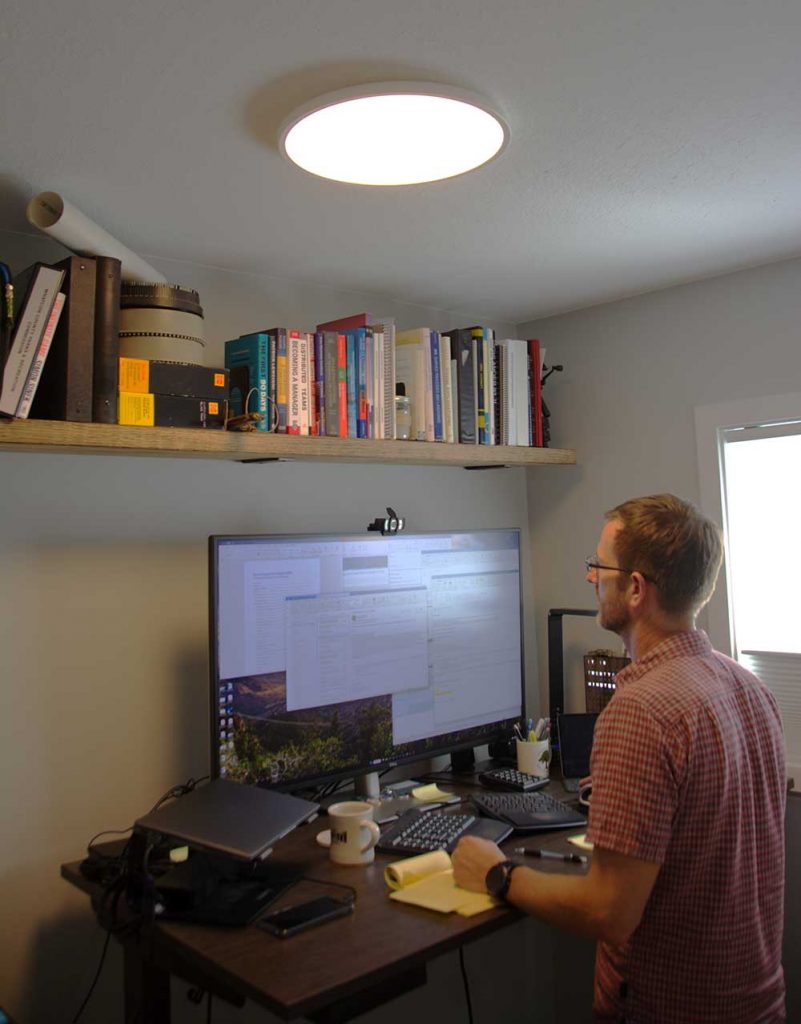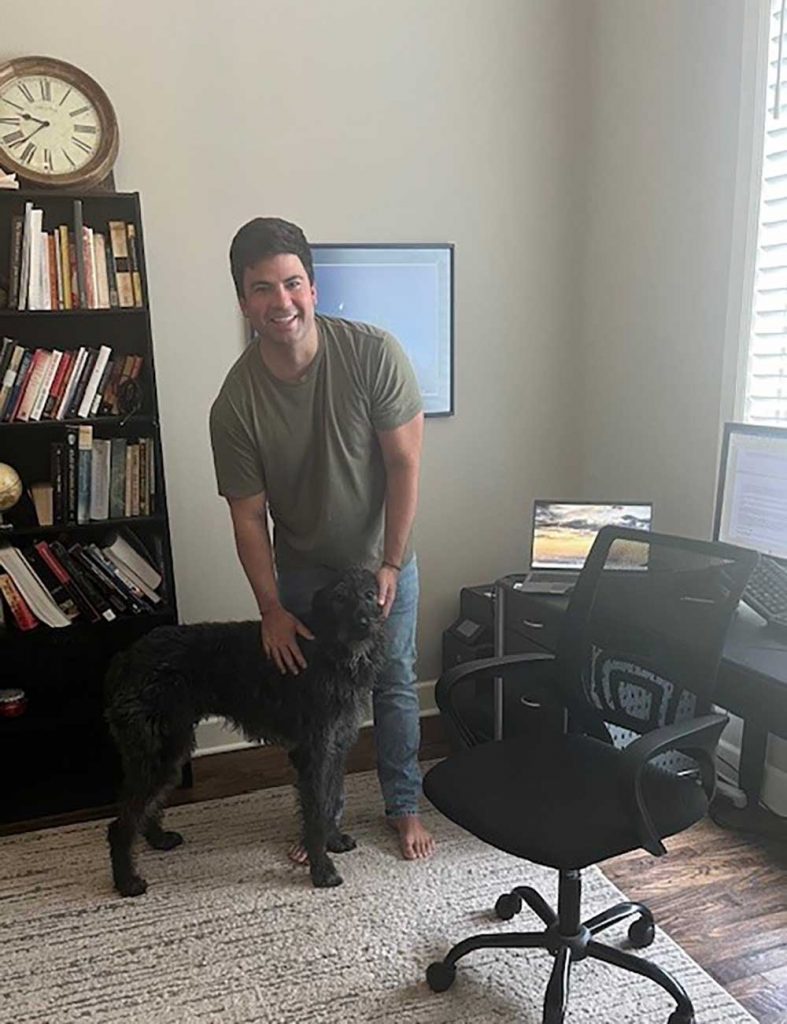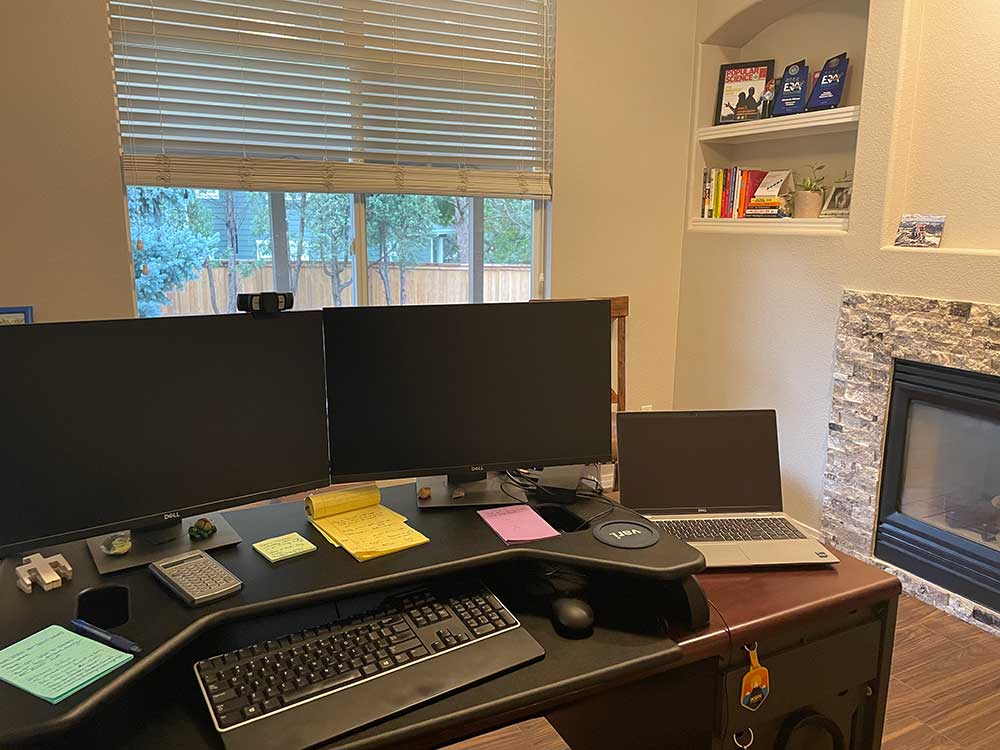How Sandians across the country use technology to impact the mission and remain connected

Think back to your last Teams call. Do you know where each participant was located? Do they work on-site, telecommute or are they remote workers? Do they live in your town — or even your state?
Thanks to many virtual communication tools and modern workplace flexibility, many Sandians support diverse research and development projects from across the country. Impactful work and collaboration are no longer confined to a building or a site.
While select Sandians were remote before the mass transition to telework in 2020 during the COVID-19 pandemic, others were forced into uncharted waters — working from home on kitchen tables, at makeshift desks and in converted closets.
As the pandemic eased and the world transitioned to a new normal, many Sandians settled into a novel way of engaging with the culture, mission and management as full-time remote workers and telecommuters. Daily rituals changed, commutes were eradicated or greatly reduced, and newfound workspaces emerged in home offices. Technology became the tie that binds us together and, in some ways, makes teams closer and more accessible than ever before.
Diana Hackenburg, a climate communications specialist, has been a remote worker since starting at Sandia in 2021. She lives in Santa Fe, New Mexico, and while she still frequently visits the Albuquerque site, she appreciates that her remote setup reduces commute frequency, increases efficiency and reduces her carbon footprint.
“I really dislike driving. Being able to work remotely means not only reducing stress and saving time from commuting but it also has allowed us to keep just one vehicle, saving money and further reducing our carbon footprint,” Diana said. “In addition to the personal benefits, I also see the corporate and global benefits. By allowing remote workers, Sandia can reduce its carbon footprint in both the energy it takes to run facilities and the indirect emissions associated with activities like employee commuting. Remote work also allows us to use workspaces more efficiently and attract a more diverse pool of applicants.”
Diana pointed out that much of her work doesn’t necessitate being on-site, adding, “my work is inherently cross-Labs, and I collaborate often with individuals located across the country. In-person meetings aren’t an option most of the time, so working remotely makes more sense than being on-site by myself all day in an office or touchdown space.”
Increasing efficiency — at work and at home

Geoff Klise, a remote manager for Sandia’s Wind Energy Computational Sciences department, lives in Bellingham, Washington, and commends remote work for adding efficiency gains during the workday. During his 17 years at Sandia, Geoff was on-site for 15 years before moving to Washington to be closer to family.
“In my management role, I am either on calls most of the day with external collaborators or meeting with staff. While in-person meetings are important, much of my work can be done remotely,” Geoff said. “Before, my workday was less efficient — walking between buildings, driving to different tech areas — and I spent many evenings at home catching up on the items I could not get to when I was on-site. Now I find that I can complete more of my tasks during regular working hours.”
Justin Hogan, a procurement manager who lives in Oklahoma, has worked 17 years at Sandia, nine of which have been remote. Justin has been a manager for the last year and a half and appreciates the lessened commute, increased efficiency and balance remote work provides.
“There are so many benefits to working remotely — first and foremost is the work-life balance. The fact that I’m not spending time commuting to work means more time with my wife and my son, which is so important to me,” Justin said. “On top of that, the environmental impact is a big deal. I also see my productivity increase because I am able to control my work environment. All of that really does lead to increased job satisfaction.”
Like Justin, other remote Sandians expressed that working from home has positively impacted their mental health and work-life balance.

Liz Hillman, a technical business development specialist matrixed to the Energy and Homeland Security Portfolio, lives in Denver and has been a remote worker for nine of her 13 years at Sandia.
“I appreciated that remote work gave me the ability to stay at Sandia when family priorities led me to relocate from Albuquerque to Denver. I considered working in person for another national lab when I moved, but I feel much more aligned with the Sandia mission and culture and am happy I was able to stay at Sandia remotely,” Liz said. “I am also grateful for the flexibility remote work provides. I am able to help my kids get to school and be home when they arrive home, all while making meaningful contributions at work.”
Cindy Symonds, an information management professional for Sandia’s W87-1 Program, lives in Fort Wayne, Indiana, and has been a remote worker since 2021. She also appreciates the mental and physical health benefits remote work offers.
“I like the ability to focus on my physical health. I now have time to exercise without the stress of managing my kids’ schedules,” Cindy said. “I like being home when my kids return from school, which also saves on childcare costs. My kids love that I am home when they arrive. I truly appreciate the joy of spending more time with them compared to when I worked in the office.”
Navigating the changes of telework
While many remote workers embrace their status, not being on-site full-time can pose issues.
“Navigating the technologies that enable remote and hybrid work can be a challenge. Haven’t we all experienced an issue with Teams at one point or another?” Diana said. “However, I also see these technologies as an opportunity in that they can provide us advantages to help us do our jobs more efficiently and effectively. For example, being able to collaboratively edit documents is a game-changer. I am always happy to spend a few minutes walking someone through how to use those types of tools.”

Liz in Colorado also feels the benefits of remote work outweigh potential technical hiccups.
“As a result of the pandemic, Sandia has really embraced hybrid work, and many of the challenges I faced originally have gotten significantly better,” Liz said. “As long as there is more than one remote/teleworker on a team, I have found the teams function as well as the in-person teams I was part of before.”
Along with navigating technological woes, some remote workers also address common work-from-home cliches.
Justin disputes remote worker stereotypes, both as a manager and a member of the larger remote workforce.
“I think a motivated individual is motivated regardless of location. If you love your job and you are satisfied and have a work ethic, location doesn’t matter at all,” Justin said. “In supply chain we keep metrics, and last year we set a record for dollars spent — and we did it with a primarily remote workforce.”
While working remotely, Liz said she was fortunate to be promoted from a senior to principal level in her role.
“There is a stereotype that remote worker contributions are ‘less than’ in person work or that you can’t grow in your career while being a remote worker,” Liz said. “I’ve been able to challenge myself and take on new, impactful projects, even winning an individual Employee Recognition Award for Collaboration Excellence as a result of my work developing the Labs Climate Security Strategy. Remote work does not mean decreased impact or engagement.”
Maintaining a sense of belonging
Despite large geographic differences and occasional visits on-site, remote workers are still connected to the Sandia mission and culture.
“I feel as connected to the culture now as I ever have been,” Justin said. “That’s a testament to the culture in supply chain of working hard and efficiently in a compliant manner. We have fun while we work, and that’s not limited by where you sit. When you enjoy the people you work with, it doesn’t matter how you connect.”
Even in Washington state, Geoff feels connected to the newly emerging Sandia culture, including the cultural impacts of remote work.
“The Sandia culture has changed substantially since COVID-19 by allowing for more remote employees and telecommuters, so I feel like we are all trying to figure out that new baseline. It’s definitely not the same as it was when on-site work was the norm,” Geoff said. “I believe I am doing the best I can at keeping staff engaged, especially with the variety of telecommuting agreements in my own department. The connection is different and requires more effort to maintain. However, I think it’s working well based on the passion staff have for their research and little-to-no attrition in the department.”

Sandia’s dedication to embracing the modern workforce means embracing cultural changes, such as remote work and telecommuting. Despite living across the country, many remote workers and teleworkers at Sandia experience increased efficiency, positive work-life balance and a tie to their teams and tasks. Regardless of location, all Sandians can connect with the mission and the culture and feel a sense of belonging.
Diana shared that remote work does not mean a lessened or insincere connection. In fact, remote work provides an opportunity to connect more frequently, regardless of location.
“I feel very connected to my coworkers at Sandia, in part because my managers have made concerted efforts to build rapport between team members. Even though I may never meet some people in person or have only met them a couple of times, I get the sense that they care about who I am as a person,” Diana said. “Other activities like our division all-hands meetings and the Sandia podcast make me feel part of a team that’s working toward common goals even if we’re working on separate projects to meet those goals.”